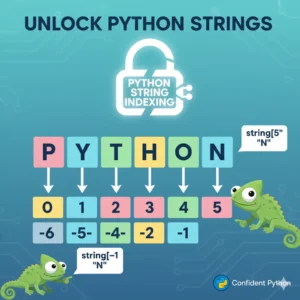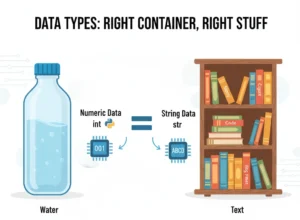Have you ever been writing a Python class and thought, “This is getting complex. I wish I could group some of this data together in a more organized way?” Just as we use classes to bundle related data and functions, sometimes a class itself can benefit from having a smaller, more specialized class living inside it.
This is the power of inner classes (or nested classes). If you’ve ever struggled to manage multiple related attributes, this guide is for you. By the end, you’ll understand what inner classes are, why they’re useful, and how to use them to write cleaner, more logical Python code.
What Are Python Inner Classes?
In simple terms, an inner class is a class defined within the body of another class. The outer class is like a container, and the inner class is a specialized component that belongs to it.
Think of it like a car. The Car is the outer class. Inside it, you might have inner classes like Engine, Door, and Radio. Each of these components has its own properties and behaviors, but they all exist within the context of the car.
Let’s prove that Python supports this concept with a quick example.
class OuterClass:
"""This is the outer class."""
class InnerClass:
"""This is the inner class, defined inside OuterClass."""
pass
# Running this code produces no errors, confirming inner classes are valid!A Practical Example: Why Use Inner Classes?
The video gives a great real-world scenario: building an OnlineMeeting class for an app like Zoom or Google Meet.
Every meeting needs a date. At first, you might be tempted to handle the date as three separate integer attributes in the OnlineMeeting class: dd, mm, and yyyy.
# Method 1: Without an Inner Class (Messy)
class OnlineMeeting:
def __init__(self, meeting_id):
self.id = meeting_id
# We'll set the date later, but it will be three separate variables.
self.dd = None
self.mm = None
self.yyyy = None
def set_date(self, dd, mm, yyyy):
self.dd = dd
self.mm = mm
self.yyyy = yyyyThis works, but it’s not very organized. The OnlineMeeting instance now has four attributes that are all on the same level: id, dd, mm, and yyyy. What if you need to pass the date around your program? You’d have to manage three variables every time.
This is where inner classes shine. We can create a Date class to bundle these three related pieces of data into a single, coherent unit.
How to Implement an Inner Class
Let’s refactor our OnlineMeeting class to use a Date inner class.
class OnlineMeeting:
"""Outer class to represent an online meeting."""
class Date:
"""Inner class to represent a specific date."""
def __init__(self, dd, mm, yyyy):
self.dd = dd
self.mm = mm
self.yyyy = yyyy
def __init__(self, meeting_id, dd, mm, yyyy):
self.id = meeting_id
# Create an instance of the INNER class
self.date = self.Date(dd, mm, yyyy) # Note the use of 'self.Date'
# Creating an OnlineMeeting object
meeting_1 = OnlineMeeting(1234, 1, 1, 2027)
print(meeting_1.id) # Output: 1234
print(meeting_1.date) # Output: <__main__.OnlineMeeting.Date object at 0x...>Notice how we create the inner class object using self.Date(...). Because the Date class is defined within OnlineMeeting, we need to access it through the outer class, in this case, via the instance self.
Accessing Inner Class Attributes
To get the actual day, month, and year from our meeting_1 object, we need to drill down into the date attribute.
# Accessing the inner class attributes
print(meeting_1.date.dd) # Output: 1
print(meeting_1.date.mm) # Output: 1
print(meeting_1.date.yyyy) # Output: 2027This structure is much cleaner! Now, the OnlineMeeting instance has two clear attributes: a simple id and a composite date object. This makes your code more readable and maintainable.
A Key Point: Inner Classes are Contained
A crucial thing to remember is that the inner class is primarily meant to be used by the outer class. You cannot directly create an object of the inner class from outside the outer class’s context.
# This will NOT work and will raise a NameError
my_date = Date(1, 1, 2027)However, you can access the inner class by specifying the outer class’s namespace.
# This WILL work because we specify OnlineMeeting.Date
my_date = OnlineMeeting.Date(1, 1, 2027)
print(my_date.dd) # Output: 1Ready to Go from Basics to Pro?
You’ve just taken a solid step into more advanced object-oriented programming in Python. Mastering concepts like inner classes helps you structure complex applications and think like a professional software engineer.
If you’re serious about mastering Python, check out our pre-recorded python comprehensive video course.
Conclusion
In this guide, you learned that Python inner classes are a powerful tool for code organization. By bundling related attributes into a nested class, you can create more logical and manageable programs. We saw how an OnlineMeeting class can neatly contain a Date inner class, moving from a clunky structure with multiple separate variables to a clean, object-oriented design. Remember, the key to mastering these concepts is practice, so try building a class with an inner class yourself!
Common Questions About Python Inner Classes
When should I use an inner class?
Use an inner class when you have a class that is so tightly coupled to another class that it doesn’t make sense for it to exist on its own. In our example, the Date class was designed specifically for the OnlineMeeting.
Can an inner class exist without an outer class?
No. An inner class is defined within an outer class. While you can create its object using OuterClass.InnerClass(), it is still conceptually tied to the outer class and cannot be defined independently.
What’s the difference between an inner class and just using another separate class?
The main difference is organization and namespace. An inner class explicitly signals that it is a component of the outer class. It keeps your codebase neat by placing closely related classes together.















